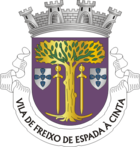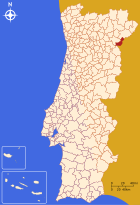Freixo de Espada à Cinta
| Freixo de Espada à Cinta | ||||||
|---|---|---|---|---|---|---|
|
||||||
| Basic data | ||||||
| Region : | Norte | |||||
| Sub-region : | Douro | |||||
| District : | Bragança | |||||
| Concelho : | Freixo de Espada à Cinta | |||||
| Coordinates : | 41 ° 5 ′ N , 6 ° 48 ′ W | |||||
| Residents: | 2199 (as of June 30, 2011) | |||||
| Surface: | 74.76 km² (as of January 1, 2010) | |||||
| Population density : | 29 inhabitants per km² | |||||
| Freixo de Espada à Cinta district | ||||||
|
||||||
| Residents: | 3780 (as of June 30, 2011) | |||||
| Surface: | 244.15 km² (as of January 1, 2010) | |||||
| Population density : | 15 inhabitants per km² | |||||
| Number of municipalities : | 4th | |||||
| administration | ||||||
| Administration address: | Câmara Municipal de Freixo de Espada à Cinta Av. Guerra Junqueiro 5180-104 Freixo de Espada à Cinta |
|||||
| President of the Câmara Municipal: | José Manuel Caldeira Santos ( PS ) | |||||
| Website: | www.cm-freixoespadacinta.pt | |||||
Freixo de Espada à Cinta ( Portuguese for: ash with sword in belt) is a small town ( Vila ) and a district ( concelho ) in Portugal with 2199 inhabitants (as of June 30, 2011).
It belongs to the Rede de Judiarias , an association of places with historically significant Jewish communities.
history
A settlement of the Narbasi is believed to be the origin of the place, but there is no evidence. During the conflict of King Alfonso II with the Kingdom of León , Freixo de Espada à Cinta came to León in 1211. King Sancho II then carried on the wars of defense against the attempts at conquest of the neighbors, and with the help of the resistance of the population, who broke a siege by the troops of the later King Alfonso X (Castile) , Freixo de Espada à Cinta fell back to Portugal in 1236 . Sancho II raised the place to a vila (small town) in 1240, and King D.Afonso III. confirmed in 1248 the town charter ( Foral ), which was probably first granted by D.Afonso Henriques in 1152 .
1273 renewed and expanded Alfons III. the town charter of the place. In 1307 the place also received regional market rights from King D Dinis . There was an important Jewish community in the village, especially after all Jews were expelled from Castile and Aragon in 1492.
King Manuel I renewed and confirmed the town charter in 1512. In the course of the Restoration War , today's district was often the focus of disputes, especially during the looting of Lagoaça and Fornos in 1644.
The previously independent circle of Freixo de Espada à Cinta came to Torre de Moncorvo in 1896 , in order to be independent again since 1898 thanks to the protest of its population.
The place name and its legends
The name literally means ash with sword on belt . The curious name gives the place a relative fame in the country today. Occasionally, with Freixo Espada Cinta , a slightly abbreviated, more ancient spelling is used.
Various legends are associated with the name. The most popular legend is the story of King D. Dinis (1261–1325). He is said to have arrived here tired, hung his sword with belt on an ash tree, and fell asleep under her. The tree was henceforth called Ash with a sword on its belt , and the name was subsequently transferred to the place. Some even want the exact tree to be clearly identified.
Another legend names the knight Feijão as the founder of the place. He is said to have been a cousin of the knight São Rosendo, who died in 977. According to legend, he was armed with a sword and an ash wood, after which the local population named the emerging place.
Another legend calls the captain Espadacinta, who rested under an ash tree, which is said to have given the name of the emerging settlement from that point on.
In view of the lack of finds and evidence of the actual origins of the place, these legends were popularly used as a makeshift explanation of its foundation.
administration
The circle
Freixo de Espada à Cinta is the seat of a district of the same name, which borders on Spain to the east . The neighboring districts are (starting clockwise in the north): Mogadouro , Figueira de Castelo Rodrigo , Vila Nova de Foz Côa and Torre de Moncorvo .
With the regional reform in September 2013, several municipalities were merged into new municipalities, so that the number of municipalities decreased from six to four.
The following municipalities ( freguesias ) are in the Freixo de Espada à Cinta district:
| local community | Population (2011) |
Area km² |
Density of population / km² |
LAU code |
|---|---|---|---|---|
| Freixo de Espa da À Cinta e Mazouco | 2,355 | 93.45 | 25th | 040407 |
| Ligares | 397 | 45.69 | 9 | 040404 |
| Lagoaça e Fornos | 617 | 64.27 | 10 | 040408 |
| Poiares | 411 | 40.74 | 10 | 040406 |
| Freixo de Espada à Cinta district | 3,780 | 244.15 | 15th | 0404 |
Population development
| Population in the Freixo de Espada à Cinta district (1801–2011) | |||||||||
|---|---|---|---|---|---|---|---|---|---|
| 1801 | 1849 | 1900 | 1930 | 1960 | 1981 | 1991 | 2001 | 2011 | |
| 3568 | 4583 | 6848 | 7034 | 7288 | 5717 | 4914 | 4184 | 3780 | |
sons and daughters of the town
- Jorge Álvares († 1521), navigator; first European to reach China by ship
- António José Antunes Navarro (1803–1867), Mayor of Porto
- Guerra Junqueiro (1850–1923), writer, poet, politician and diplomat
- Manuel Carlos Quintão Meireles (1880–1962), naval chief and foreign minister
- Manuel Maria Sarmento Rodrigues (1899–1979), admiral and colonial administrator
- Manuel Teixeira (1912–2003), historian and missionary; became a well-known figure in Macau
- Manuel Neto Quintas (* 1949), Bishop of Faro
Web links
- Map of the Freguesia Freixo de Espada à Cinta at the Instituto Geográfico do Exército
- Official website
Individual evidence
- ↑ www.ine.pt - indicator resident population by place of residence and sex; Decennial in the database of the Instituto Nacional de Estatística
- ↑ a b Overview of code assignments from Freguesias on epp.eurostat.ec.europa.eu
- ↑ www.ine.pt - indicator resident population by place of residence and sex; Decennial in the database of the Instituto Nacional de Estatística
- ↑ www.verportugal.net , accessed January 26, 2013
- ^ João Fonseca: Dicionário do Nome das Terras. 2nd edition, Casa das Letras, Cruz Quebrada 2007, page 119f ( ISBN 978-972-46-1730-5 )
- ^ Publication of the administrative reorganization in the Diário da República gazette of January 28, 2013, accessed on March 16, 2014







